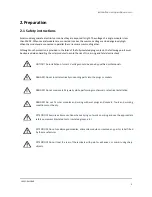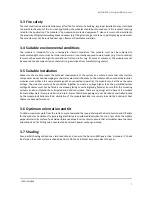
installation and operation manual
IM-S1-EN-18V0
7
3.3
Fire safety
The roof construction and installation may affect the fire safety of a building; improper installation may contribute
to hazards in the event of fire. For roof application, the modules should be mounted over a fire resistant covering
rated for the application. The module is “non-explosion-protected equipment”. Hence it must not be installed in
the proximity of highly flammable gases and vapors (e.g. filling stations, gas containers, paint spraying equipment).
The module must not be installed near open flames or flammable materials.
3.4
Suitable environmental conditions
The module is intended for use in temperate climatic conditions. The module must not be subjected to
concentrated light. It must not be immersed in water or constantly exposed to water spray (e.g. from fountains).
It must not be exposed to high concentrations of salt and sulfur (e.g. from sea or volcanos). The module may not
be exposed to extremely corrosive chemicals (e.g. emissions from manufacturing plants).
3.5
Suitable installation
Make sure the module meets the technical requirements of the system as a whole. Ensure that other system
components do not exert damaging mechanical or electrical influences on the modules. When connected in series,
modules must all have the same amperage. When connected in parallel, the modules must all have the same
voltage. The modules must not be connected together to create a voltage higher than the permitted system
voltage. Modules must not be fitted as overhead glazing or vertical glazing (façade). Ensure that the mounting
system can also withstand the anticipated wind and snow loads. There are openings at the base of the module
frame to allow water from precipitation to drain. Ensure that these openings are not blocked nor partially blocked
by the module installation method. Ventilation of the module backside is necessary to avoid the build-up of heat
that can reduce performance.
3.6
Optimum orientation and tilt
To obtain maximum yield from the system, we recommend that you determine the best direction and tilt angle
for the modules. Conditions for generating electricity are considered ideal when the sun’s rays strike the module
perpendicular to its surface. To avoid performance drops in series circuits, ensure that all modules have the same
orientation and tilt. Failing to do so voids the Autarco AC power output guarantee.
3.7
Shading
Even partial shading will cause a yield reduction and can void the Autarco kWh guarantee. A module is “shade
free” when the entire surface is shade free from 10:00 to 15:00 local time every day of the year.



























